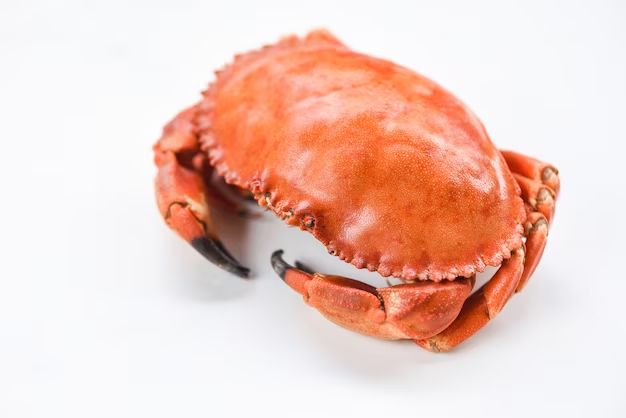Stone crabs are a popular delicacy found in coastal regions of the southeast United States and the Gulf of Mexico. Their large, meaty claws make them a prized seafood item. However, stone crab fisheries face sustainability challenges, with some populations in decline. This raises an important question for seafood lovers and fishers alike: what crab is similar to stone crab that could serve as a sustainable alternative?
Anatomy of the Stone Crab
Stone crabs belong to the genus Menippe, which contains two species – the Florida stone crab (Menippe mercenaria) and the Gulf stone crab (Menippe adina). They have a carapace (shell) that averages 4-6 inches wide, with males growing slightly larger than females. Their most distinctive feature is their massive crusher claw, which is larger and stronger than the other pincer claw. The crusher claw can apply extreme pressure, enabling the crab to crush mollusk shells and other hard-shelled prey.
Stone crabs are bottom-dwelling crabs usually found on limestone bottoms, coral reefs, jetties, and other rocky habitats. They prefer shallow waters no deeper than 300 feet. Their habitat ranges along the Atlantic coast from North Carolina to the Florida Keys, and throughout the Gulf of Mexico. The highest population densities occur off southern Florida and the Florida Keys.
Stone Crab Fishery and Sustainability Concerns
Stone crabs are fished commercially throughout their range. The fishery focuses solely on the claws. Crabbers remove one or both claws from the live crabs, then return them to the water where they can regrow the lost claw(s) over time. Fishing regulations prohibit taking of whole crabs, and enforce size and season limitations to support population replenishment.
The stone crab fishery faces several sustainability challenges:
- Overfishing – Crabbers often take both claws, reducing reproductive capacity
- High bycatch mortality – Many crabs die from injuries/stress after claw removal
- Habitat damage from traps
- Declining populations in certain regions
To address these concerns, fishery managers have implemented stricter size limits, shorter seasons, trap modifications to reduce bycatch, and claw removal limits. However, the fishery remains controversial among conservationists, highlighting the need for alternative crab options.
Finding a Sustainable Alternative to Stone Crab
The ideal alternative crab should meet the following criteria:
- Large, meaty claws similar to stone crab
- Non-threatened conservation status with healthy populations
- Derived from well-managed, sustainable fisheries with minimal bycatch
- Comparable rich, sweet flavor
Several crabs match some of these parameters. However, based on a full evaluation, the Jonah crab emerges as the closest thing to a sustainable substitute for stone crab claws.
Jonah Crab Overview
The Jonah crab (Cancer borealis) is a crab native to the northwest Atlantic, ranging from Newfoundland, Canada to Florida. It inhabits depths between 10-750 feet. Jonah crabs have a brownish-red carapace reaching up to 7 inches wide. Their claws are black-tipped with a reddish-brown base color.
Jonah crabs and stone crabs share a very similar claw structure – large, robust crusher claw with smaller pincer claw. In fact, Jonah crab claws are sometimes mislabeled as stone crab in markets.
Sustainability of Jonah Crab Fisheries
The Jonah crab fishery developed as a bycatch fishery of the American lobster industry. Today, there are directed fisheries for Jonah crabs along the Atlantic coast and Gulf of Maine. Landings have increased substantially in recent decades in response to market demand.
Fishery management appears quite sustainable for Jonah crab populations:
- No major population declines reported – biomass remains high
- Strict minimum size limits in place – 4.75″ carapace width
- Prohibits retention of egg-bearing females
- Gear restrictions and trap limits to control fishing effort
- Claw fishery only – crabs returned alive to minimize mortality
Bycatch rates are also low, making this a relatively clean fishery. The Jonah crab’s healthy numbers and well-managed fishery make it a smart and sustainable seafood choice.
How Jonah Crab Claws Compare to Stone Crab
| Attribute | Jonah Crab Claw | Stone Crab Claw |
|---|---|---|
| Size | Slightly smaller | Larger |
| Meat fill | Comparable meat-to-shell ratio | Slightly higher fill |
| Texture | Firm, tender, moist | Firm, tender, moist |
| Flavor | Sweet, delicate, briny | Sweeter, intense briny flavor |
| Price | More affordable | Higher price |
In summary, Jonah crab claws are slightly smaller with a delicate sweetness compared to the larger, richer-flavored stone crab claws. But they offer an impressive meat-to-shell ratio and tender texture on par with stone crab. Given the sustainability advantages, Jonah crab claws emerge as the most eco-friendly alternative to stone crab claws currently available.
Preparing and Cooking Jonah Crab Claws
Jonah crab claws can be prepared and served much like stone crab claws. Here are some popular options:
- Cracked and served cold – Crack the shell and serve the chilled claw meat with lemon wedges and cocktail sauce for dipping.
- Quick boiled or steamed – Boil or steam the claws for 8-10 minutes until the shell turns red. Crack the shell to access the hot meat.
- Oven-roasted – Roast the claws in a 400°F oven for 10-12 minutes until the shell loosens. Pry open the shell and enjoy the roasted meat.
- Sautéed – Sauté chopped claw meat in butter or olive oil with garlic, lemon, white wine and herbs.
- Crab cakes – Combine lump crab claw meat with bread crumbs, egg, aromatics and form into cakes, then pan-fry until golden brown.
With their impressively large, meaty claws, mild sweet flavor and sustainable fishery, Jonah crabs represent an excellent solution for environmentally responsible seafoodies searching for an alternative to stone crab claws.
Conclusion
Stone crab populations face concerning declines in some regions. In looking for a sustainable substitute claw, Jonah crab emerges as the closest match. With its large crusher claw, tender texture, sweet flavor, and well-managed fishery, the Jonah crab offers an eco-friendly way to enjoy delicious crab claws with minimal environmental impact.


